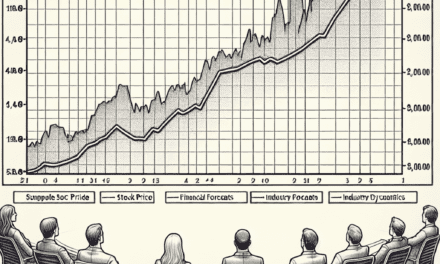“Moderna’s Earnings Shine, But Market Optimism Fades.”
Introduction
Moderna experienced a premarket surge that ultimately dimmed despite reporting earnings that surpassed expectations. The biotechnology company, known for its mRNA-based COVID-19 vaccine, initially saw a rise in its stock value following the announcement of its quarterly financial results. These results highlighted a stronger-than-anticipated performance, driven by robust vaccine sales and strategic advancements in its pipeline. However, the initial enthusiasm in the market was tempered by broader concerns, including potential challenges in sustaining vaccine demand and competition from other pharmaceutical companies. As a result, the early gains in Moderna’s stock price were moderated, reflecting a cautious investor sentiment despite the earnings ‘beat.’
Analysis Of Moderna’s Earnings Report: Key Takeaways
Moderna’s recent earnings report has captured the attention of investors and analysts alike, as the biotechnology company continues to navigate the complexities of the post-pandemic landscape. Initially, the premarket trading session saw a surge in Moderna’s stock, driven by the anticipation of strong financial performance. However, as the details of the earnings report were digested, the initial enthusiasm began to wane, leading to a more tempered market response. This shift in sentiment underscores the nuanced nature of Moderna’s current financial standing and future prospects.
The earnings report revealed that Moderna had indeed surpassed Wall Street’s expectations, delivering a performance that many would categorize as a ‘beat.’ The company’s revenue and earnings per share both exceeded analyst forecasts, a testament to its robust operational execution. This outperformance was largely attributed to the continued demand for its COVID-19 vaccine, which remains a significant revenue driver. Despite the global decline in COVID-19 cases, the vaccine’s relevance persists, particularly in regions where vaccination rates are still climbing or where booster shots are being administered.
However, the initial optimism was tempered by several factors that emerged from the earnings report. One of the primary concerns is the sustainability of Moderna’s revenue growth in the face of declining pandemic-related demand. As the world gradually transitions to a post-pandemic normal, the reliance on COVID-19 vaccines is expected to diminish. This anticipated decline raises questions about Moderna’s ability to maintain its revenue trajectory and highlights the importance of its pipeline diversification efforts.
In response to these challenges, Moderna has been actively investing in research and development to expand its portfolio beyond COVID-19 vaccines. The company is exploring a range of therapeutic areas, including oncology, rare diseases, and other infectious diseases, leveraging its mRNA technology platform. While these initiatives hold promise, they are still in various stages of development and will require time to materialize into substantial revenue streams. Consequently, investors are closely monitoring the progress of these programs, as their success is critical to Moderna’s long-term growth strategy.
Another factor contributing to the muted market reaction is the broader economic environment, which has been characterized by volatility and uncertainty. Inflationary pressures, interest rate hikes, and geopolitical tensions have all contributed to a cautious investor sentiment, affecting the biotechnology sector as a whole. In this context, even companies that report strong earnings may experience subdued stock performance, as market participants weigh the potential risks and rewards.
Moreover, Moderna’s valuation has been a topic of debate among analysts. While the company’s innovative technology and strong financial performance are undeniable, some argue that its stock price may already reflect these positives, leaving limited room for further appreciation. This perspective suggests that investors are seeking additional catalysts, such as successful product launches or strategic partnerships, to justify a higher valuation.
In conclusion, Moderna’s earnings report presents a complex picture of a company that is both thriving and facing significant challenges. While the earnings ‘beat’ is a positive indicator of its current operational strength, the market’s tempered response highlights the uncertainties surrounding its future growth prospects. As Moderna continues to navigate this evolving landscape, its ability to innovate and adapt will be crucial in determining its long-term success. Investors and analysts will undoubtedly keep a close watch on the company’s strategic initiatives and market developments, as they seek to assess its potential in a rapidly changing world.
Factors Contributing To Moderna’s Premarket Surge
Moderna’s premarket surge, initially fueled by an impressive earnings report, has dimmed as the trading day progresses. The biotechnology company, known for its pivotal role in developing one of the first COVID-19 vaccines, recently announced quarterly earnings that exceeded Wall Street’s expectations. This earnings “beat” was primarily driven by higher-than-anticipated sales of its COVID-19 vaccine, which continues to be a significant revenue stream for the company. However, despite this positive financial performance, several factors have contributed to the fading enthusiasm in the premarket trading session.
To begin with, the initial surge in Moderna’s stock can be attributed to the company’s ability to outperform analysts’ predictions. Investors often react positively to such earnings surprises, as they indicate robust business performance and potential for future growth. In Moderna’s case, the higher-than-expected vaccine sales were a testament to the ongoing demand for COVID-19 vaccinations, particularly in light of emerging variants and booster shot requirements. This demand has provided a steady revenue stream, bolstering investor confidence in the company’s financial health.
Moreover, Moderna’s strategic initiatives have played a crucial role in its premarket surge. The company has been actively expanding its pipeline beyond COVID-19 vaccines, investing in research and development for other mRNA-based therapies. This diversification strategy is seen as a positive move by investors, as it reduces the company’s reliance on a single product and opens up new revenue opportunities. The potential for breakthroughs in areas such as cancer treatment and rare diseases has generated optimism about Moderna’s long-term growth prospects.
However, despite these positive developments, several factors have tempered the initial enthusiasm surrounding Moderna’s stock. One significant concern is the increasing competition in the COVID-19 vaccine market. As more pharmaceutical companies develop and distribute their vaccines, Moderna faces the challenge of maintaining its market share. This competitive pressure could potentially impact future sales and profitability, leading investors to reassess their expectations.
Additionally, regulatory and logistical challenges continue to pose risks to Moderna’s operations. The company must navigate complex regulatory environments in various countries to ensure the approval and distribution of its vaccines. Any delays or setbacks in this process could adversely affect its financial performance and stock valuation. Furthermore, supply chain disruptions and production challenges remain a concern, as they can hinder the company’s ability to meet global demand efficiently.
Another factor contributing to the dimming of Moderna’s premarket surge is the broader market sentiment. Investors are increasingly cautious amid economic uncertainties, such as inflationary pressures and potential interest rate hikes. These macroeconomic factors can influence investor behavior, leading to fluctuations in stock prices regardless of individual company performance. As a result, even companies like Moderna, with strong earnings reports, may experience volatility in their stock prices.
In conclusion, while Moderna’s premarket surge was initially driven by an impressive earnings report and strategic initiatives, several factors have contributed to the subsequent dimming of enthusiasm. The competitive landscape, regulatory challenges, and broader market sentiment all play a role in shaping investor perceptions and stock performance. As Moderna continues to navigate these complexities, its ability to adapt and innovate will be crucial in sustaining long-term growth and maintaining investor confidence.
Understanding The Market Reaction To Moderna’s Earnings ‘Beat’
Moderna’s recent financial performance has captured the attention of investors and analysts alike, as the biotechnology company reported earnings that surpassed market expectations. Despite this apparent success, the premarket surge in Moderna’s stock price was short-lived, leaving many to ponder the underlying reasons for this muted market reaction. To understand this phenomenon, it is essential to delve into the broader context of Moderna’s business operations, market conditions, and investor sentiment.
Initially, Moderna’s earnings report appeared promising, with the company posting higher-than-expected revenue and profit figures. This performance was largely driven by the continued demand for its COVID-19 vaccine, which has been a significant revenue stream since its introduction. The earnings ‘beat’ was anticipated to bolster investor confidence, leading to a premarket rally in the company’s stock. However, as trading commenced, the enthusiasm waned, and the stock’s upward momentum diminished.
One factor contributing to this tempered response is the evolving landscape of the COVID-19 pandemic. As vaccination rates increase globally and new variants emerge, the demand dynamics for vaccines are shifting. Investors are increasingly concerned about the sustainability of Moderna’s vaccine-driven revenue, especially as competitors introduce updated vaccines and treatments. This uncertainty about future demand may have tempered the initial excitement surrounding the earnings report.
Moreover, the broader market environment has been characterized by volatility and cautious sentiment. Economic indicators, such as inflation rates and interest rate hikes, have created an atmosphere of uncertainty, prompting investors to adopt a more conservative approach. In such a climate, even companies that report strong earnings may not experience the expected stock price appreciation, as market participants weigh broader economic risks against individual corporate performance.
Additionally, Moderna’s stock has been subject to significant fluctuations in recent months, influenced by both company-specific developments and external factors. The biotechnology sector, in particular, is known for its inherent volatility, driven by regulatory changes, scientific breakthroughs, and competitive pressures. Investors may be wary of these fluctuations, opting to take a more measured approach despite positive earnings news.
Furthermore, while Moderna’s earnings exceeded expectations, some analysts have raised concerns about the company’s long-term growth prospects beyond its COVID-19 vaccine. The market is keenly interested in Moderna’s pipeline of other mRNA-based therapeutics and vaccines, which are still in various stages of development. The success of these products is crucial for sustaining the company’s growth trajectory, and any perceived delays or setbacks could weigh on investor sentiment.
In conclusion, while Moderna’s earnings ‘beat’ initially sparked optimism, a confluence of factors contributed to the subsequent dimming of its premarket surge. The shifting dynamics of the COVID-19 vaccine market, broader economic uncertainties, and the inherent volatility of the biotechnology sector all played a role in shaping investor reactions. As Moderna continues to navigate these challenges, its ability to diversify its product portfolio and demonstrate long-term growth potential will be critical in regaining investor confidence. Understanding these complexities provides valuable insights into the market’s nuanced response to what, on the surface, appeared to be a positive earnings report.
The Impact Of Vaccine Sales On Moderna’s Financial Performance
Moderna’s recent financial performance has been a topic of considerable interest, particularly in light of its role in the global COVID-19 vaccination effort. The company’s premarket surge, initially fueled by an earnings report that exceeded expectations, has since dimmed, raising questions about the sustainability of its financial momentum. At the heart of this discussion is the impact of vaccine sales on Moderna’s overall financial health, which has been both a boon and a challenge for the biotechnology firm.
To begin with, Moderna’s earnings report revealed a significant ‘beat’ on Wall Street expectations, primarily driven by robust sales of its COVID-19 vaccine. This performance underscored the company’s ability to capitalize on the unprecedented demand for vaccines, which has been a critical factor in its recent financial success. The revenue generated from vaccine sales has not only bolstered Moderna’s bottom line but also provided the company with the resources to invest in further research and development. This investment is crucial as Moderna seeks to expand its portfolio beyond COVID-19 vaccines, aiming to leverage its mRNA technology for other therapeutic areas.
However, despite the initial positive reaction to the earnings report, the premarket surge in Moderna’s stock price has since waned. This shift reflects broader market concerns about the long-term sustainability of vaccine-driven revenue. As the global vaccination campaign progresses and the pandemic’s acute phase potentially wanes, there is uncertainty about the future demand for COVID-19 vaccines. This uncertainty is compounded by the emergence of new competitors and the potential for market saturation, which could impact Moderna’s market share and pricing power.
Moreover, the company’s reliance on vaccine sales highlights a broader challenge: the need to diversify its revenue streams. While the success of its COVID-19 vaccine has been transformative, Moderna’s future growth will depend on its ability to develop and commercialize new products. The company is actively pursuing this strategy, with several candidates in its pipeline targeting a range of diseases, including influenza, HIV, and cancer. These efforts are promising, yet they also entail significant research and development costs, regulatory hurdles, and competitive pressures.
In addition to these strategic considerations, Moderna must navigate the evolving landscape of public health policy and vaccine distribution. Governments worldwide are reassessing their vaccination strategies, which could influence future procurement and pricing agreements. Furthermore, the potential need for booster shots and the development of variant-specific vaccines add layers of complexity to Moderna’s planning and forecasting.
In conclusion, while Moderna’s recent earnings ‘beat’ highlights the positive impact of vaccine sales on its financial performance, the subsequent dimming of its premarket surge underscores the challenges ahead. The company must balance the immediate benefits of its COVID-19 vaccine success with the imperative to diversify and innovate. As Moderna continues to navigate this dynamic environment, its ability to adapt and evolve will be critical to sustaining its financial performance and achieving long-term growth. The coming months and years will be pivotal as Moderna seeks to solidify its position as a leader in the biotechnology industry, leveraging its mRNA technology to address a broader array of global health challenges.
Investor Sentiment: Why Moderna’s Surge Diminished
Moderna’s recent premarket surge, initially fueled by an earnings report that exceeded Wall Street expectations, has seen its momentum diminish, leaving investors to ponder the underlying factors influencing this shift in sentiment. The biotechnology company, renowned for its pivotal role in developing one of the first COVID-19 vaccines, reported earnings that surpassed analysts’ forecasts, a development that typically ignites investor enthusiasm. However, despite this ostensibly positive news, the initial surge in Moderna’s stock price was not sustained, prompting a closer examination of the broader context and investor sentiment.
To begin with, Moderna’s earnings report highlighted robust financial performance, with revenue figures that outpaced projections. This was largely attributed to continued demand for its COVID-19 vaccine, particularly in international markets where vaccination rates are still climbing. Additionally, the company has been making strides in expanding its pipeline beyond COVID-19, with promising developments in mRNA technology for other infectious diseases and potential therapeutic applications. These factors collectively painted a picture of a company not only capitalizing on its existing products but also strategically positioning itself for future growth.
Nevertheless, the initial optimism was tempered by several factors that have contributed to a more cautious investor outlook. One significant concern is the evolving landscape of the COVID-19 pandemic itself. As vaccination rates increase globally and new variants emerge, the demand dynamics for COVID-19 vaccines are shifting. Investors are acutely aware that the extraordinary revenue generated from the pandemic may not be sustainable in the long term, leading to questions about Moderna’s ability to maintain its financial performance as the world gradually transitions to a post-pandemic phase.
Moreover, the competitive environment in the biotechnology sector is intensifying. With numerous companies racing to develop next-generation vaccines and treatments, Moderna faces the challenge of differentiating itself in a crowded market. This competitive pressure is compounded by the fact that other pharmaceutical giants are also leveraging mRNA technology, potentially eroding Moderna’s first-mover advantage. Consequently, investors are scrutinizing the company’s strategic initiatives and partnerships to assess its ability to maintain a competitive edge.
In addition to these industry-specific challenges, broader market conditions have also played a role in dampening investor enthusiasm. The stock market has been experiencing heightened volatility, driven by concerns over inflation, interest rate hikes, and geopolitical tensions. These macroeconomic factors have created an environment where investors are more risk-averse, leading to a reevaluation of high-growth stocks like Moderna. As a result, even companies with strong earnings reports are not immune to the broader market sentiment, which can overshadow individual performance metrics.
Furthermore, investor sentiment is also influenced by Moderna’s valuation, which some analysts argue may be stretched given the uncertainties surrounding its future revenue streams. While the company’s innovative technology and potential for diversification are promising, the high expectations embedded in its stock price necessitate consistent delivery of breakthrough products and sustained financial growth. This pressure to continually meet or exceed market expectations can lead to heightened sensitivity to any perceived risks or setbacks.
In conclusion, while Moderna’s earnings report initially sparked a premarket surge, the subsequent diminishment of this momentum underscores the complex interplay of factors shaping investor sentiment. From the evolving dynamics of the COVID-19 pandemic and competitive pressures to broader market conditions and valuation concerns, investors are navigating a multifaceted landscape. As Moderna continues to innovate and adapt, its ability to address these challenges will be pivotal in shaping its long-term trajectory and investor confidence.
Comparing Moderna’s Performance With Competitors
Moderna’s recent premarket surge, initially fueled by an earnings report that exceeded Wall Street expectations, has seen its momentum wane as investors reassess the broader landscape of the biotechnology sector. Despite the company’s commendable financial performance, which included a notable earnings “beat,” the competitive environment in which Moderna operates remains a critical factor influencing investor sentiment. To understand the dynamics at play, it is essential to compare Moderna’s performance with that of its key competitors, such as Pfizer and BioNTech, which are also prominent players in the mRNA vaccine space.
Moderna’s earnings report highlighted a robust revenue stream, primarily driven by its COVID-19 vaccine sales. The company’s ability to surpass earnings expectations can be attributed to its strategic partnerships and global distribution network, which have enabled it to maintain a strong market presence. However, as the pandemic evolves and the demand for vaccines stabilizes, Moderna faces the challenge of sustaining its growth trajectory. In contrast, Pfizer, with its extensive pharmaceutical portfolio, has managed to diversify its revenue sources, thereby mitigating the impact of fluctuating vaccine demand. This diversification strategy has allowed Pfizer to maintain a stable financial outlook, even as the pandemic’s urgency diminishes.
Moreover, BioNTech, Moderna’s direct competitor in the mRNA vaccine market, has also demonstrated resilience. The German biotech firm, in collaboration with Pfizer, has capitalized on its innovative mRNA technology to expand its pipeline beyond COVID-19 vaccines. This strategic expansion into other therapeutic areas, such as oncology and infectious diseases, positions BioNTech favorably in the long term. Consequently, investors are closely monitoring BioNTech’s progress, as its ability to leverage mRNA technology for diverse applications could potentially outpace Moderna’s growth.
In addition to these competitive pressures, Moderna must navigate the evolving regulatory landscape. As governments worldwide shift their focus from emergency use authorizations to full approvals and booster campaigns, companies like Moderna are compelled to adapt their strategies accordingly. This regulatory transition presents both opportunities and challenges, as it necessitates rigorous clinical trials and data transparency. While Moderna has made significant strides in securing approvals for its vaccine, the company’s future success will depend on its ability to meet these regulatory demands efficiently.
Furthermore, the competitive dynamics are not limited to vaccine development alone. The biotechnology sector is witnessing a surge in research and development activities aimed at harnessing mRNA technology for a wide array of medical applications. Companies are racing to innovate and bring new mRNA-based therapies to market, intensifying the competition. Moderna’s investment in research and development is crucial in this context, as it seeks to maintain its leadership position in the mRNA space. However, the company’s ability to translate its R&D efforts into commercially viable products remains a key determinant of its competitive edge.
In conclusion, while Moderna’s recent earnings report provided a temporary boost to its stock performance, the broader competitive landscape presents significant challenges. The company’s ability to sustain its growth will depend on its strategic responses to the evolving market dynamics and regulatory environment. By comparing Moderna’s performance with that of its competitors, it becomes evident that diversification, innovation, and regulatory agility are critical factors that will shape the future trajectory of these biotech giants. As the sector continues to evolve, investors will keenly observe how Moderna navigates these complexities to maintain its competitive position.
Future Outlook: What Lies Ahead For Moderna Post-Earnings
Moderna’s recent premarket surge, initially fueled by an earnings report that exceeded Wall Street expectations, has begun to lose its momentum. Despite the company’s ability to surpass earnings forecasts, the market’s reaction underscores a complex landscape for Moderna as it navigates the post-earnings environment. This scenario invites a closer examination of the factors influencing Moderna’s future outlook and the challenges it may face in sustaining investor confidence.
To begin with, Moderna’s earnings report revealed a robust financial performance, driven largely by its COVID-19 vaccine sales. The company reported higher-than-expected revenue and profit margins, which initially sparked optimism among investors. However, as the initial excitement waned, it became evident that the market’s focus was shifting towards the sustainability of these earnings in a post-pandemic world. The question of how Moderna will adapt its business model to maintain growth beyond its flagship vaccine remains a critical concern.
In light of this, Moderna’s strategic initiatives to diversify its product pipeline are of paramount importance. The company has been actively investing in research and development to expand its mRNA technology platform beyond COVID-19 vaccines. This includes exploring potential applications in areas such as cancer immunotherapy, rare diseases, and other infectious diseases. While these efforts hold promise, they also come with inherent risks and uncertainties. The success of these initiatives will be crucial in determining Moderna’s ability to transition from a pandemic-dependent revenue model to a more diversified and sustainable one.
Moreover, the competitive landscape in the biotechnology sector presents additional challenges for Moderna. As other pharmaceutical companies continue to advance their own mRNA-based therapies and vaccines, Moderna must navigate an increasingly crowded market. The company’s ability to differentiate its offerings and demonstrate superior efficacy and safety will be key factors in maintaining its competitive edge. Furthermore, regulatory hurdles and the need for substantial investment in clinical trials add layers of complexity to Moderna’s growth trajectory.
In addition to these strategic considerations, external factors such as global vaccination rates and the emergence of new COVID-19 variants also play a significant role in shaping Moderna’s future. While the demand for booster shots and updated vaccines may provide short-term revenue opportunities, the long-term impact of these factors remains uncertain. The company’s ability to swiftly adapt to changing public health needs and regulatory requirements will be critical in sustaining its market position.
Furthermore, investor sentiment and market dynamics continue to influence Moderna’s stock performance. The initial premarket surge following the earnings report was tempered by broader market trends and investor concerns about the biotech sector’s volatility. As such, Moderna’s management must effectively communicate its strategic vision and progress to reassure investors and mitigate potential fluctuations in stock value.
In conclusion, while Moderna’s recent earnings ‘beat’ initially sparked optimism, the subsequent dimming of its premarket surge highlights the complex challenges the company faces in the post-earnings landscape. The future outlook for Moderna hinges on its ability to diversify its product pipeline, navigate a competitive market, and adapt to evolving public health needs. As the company continues to innovate and expand its mRNA technology platform, its strategic decisions and execution will be pivotal in shaping its long-term success and sustaining investor confidence.
Q&A
1. **What caused Moderna’s premarket surge?**
Moderna’s premarket surge was initially driven by the announcement of better-than-expected earnings results.
2. **What were the key financial metrics in Moderna’s earnings report?**
Moderna reported earnings that exceeded analysts’ expectations, with higher-than-anticipated revenue figures.
3. **Why did the premarket surge dim despite the earnings beat?**
The surge dimmed due to concerns over future demand for COVID-19 vaccines and potential challenges in sustaining revenue growth.
4. **How did Moderna’s stock perform in the premarket trading?**
Moderna’s stock initially rose in premarket trading following the earnings announcement but later saw gains diminish.
5. **What are analysts saying about Moderna’s future prospects?**
Analysts have mixed views, with some expressing optimism about Moderna’s pipeline and others concerned about declining vaccine demand.
6. **Did Moderna provide any guidance for future quarters?**
Moderna provided guidance that was cautious, reflecting uncertainties in the vaccine market and potential revenue fluctuations.
7. **What other factors are influencing Moderna’s stock performance?**
Other factors include competition from other vaccine manufacturers, regulatory developments, and broader market conditions.
Conclusion
Moderna’s premarket surge following its earnings report, which initially exceeded expectations, was short-lived. Despite the company posting better-than-expected earnings, investor enthusiasm waned due to underlying concerns such as potential challenges in sustaining revenue growth, market saturation, or broader market conditions affecting biotech stocks. This suggests that while the earnings ‘beat’ provided a temporary boost, it was insufficient to maintain momentum amid broader market apprehensions or company-specific uncertainties.





